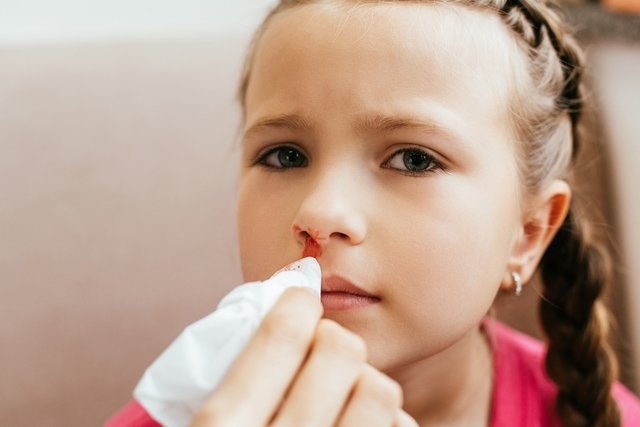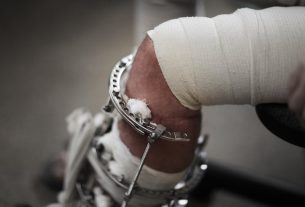Infant nosebleeds should generally not be a cause for concern and are common after blowing the nose forcefully or inhaling cold, dry air, especially in winter, but can also be caused by allergies, colds and objects placed in the nose.
Normally, nosebleeds in children are not serious and do not require specific treatment, it is only recommended that pressure be applied to the nose to stop the bleeding and keep the head tilted forward.
However, if the bleeding is frequent, it is important to consult an otorhinolaryngologist or pediatrician so that the cause can be identified and the most appropriate treatment can be started. Furthermore, if the bleeding does not stop, it is recommended to seek emergency care.

Main causes
The main causes of childhood nosebleeds are:
1. Blow your nose hard
Blowing your nose too hard can cause nosebleeds due to the rupture of some superficial vessels that exist inside the nose and are fragile.
Normally, no specific treatment is necessary, and it is recommended to avoid blowing your nose too hard, so that the bleeding does not happen again.
2. Inhaling very dry or cold air
It is common for inhaling very dry or cold air to cause nosebleeds due to the dryness of the inside of the nose, making the skin more fragile and increasing the risk of rupture of small vessels.
In this case, it is recommended to wash your nose daily with saline solution to hydrate the mucosa. Furthermore, it is important to avoid inhaling very cold air and keep the air at home humidified, with air humidifiers, for example. See some ways to humidify the air at home.
3. Hits to the face
Blows to the face, especially in the nose region, can cause nosebleeds due to the rupture of small vessels. Furthermore, they can also cause pain and swelling at the site.
In case of blows, it may be advisable to apply ice packs to the area and use analgesic medications to alleviate symptoms such as pain and swelling. However, if other symptoms appear, such as drowsiness or mental confusion, it is recommended to go to the emergency room for an evaluation.
4. Allergic rhinitis
Infant nosebleeds caused by allergic rhinitis usually occur due to inflammation of the nasal mucosa. In addition, it is common to have other symptoms, such as a runny nose and sneezing. Find out more symptoms of allergic rhinitis.
To avoid other nose bleeds, it is recommended to consult an allergist or otorhinolaryngologist if allergic rhinitis is suspected. In addition to avoiding possible allergy causes, such as pollen and dust, medications such as anti-allergens and nasal corticosteroids may be indicated.
5. Respiratory infections
Respiratory infections, such as colds and flu, can sometimes cause nosebleeds due to inflammation of the lining of the nose. In addition, it is common for other symptoms such as fever and runny nose to appear.
In this case, it is recommended to consult your pediatrician especially if symptoms such as headache or fever appear. In addition to nasal washing with saline solution, medications such as analgesics and antipyretics may also be indicated. Check out other remedies to alleviate childhood flu symptoms.
6. Non-nose objects
Sometimes, children’s nosebleeds can be caused by objects placed in the nose by the child, which can cause internal injuries. Furthermore, if the object becomes stuck, symptoms such as headache and yellowish or foul-smelling discharge from the nose may appear.
Generally, nosebleeds improve within a few minutes even without specific treatment. However, if you suspect an object is stuck inside the child’s nose, it is recommended to go to the emergency room for an evaluation.
What to do
To stop nosebleeds in children, you must:
- Keep the child calm and quietavoiding talking, laughing or crying, so that the bleeding does not get worse;
- Ask the child to sit still and keep their head tilted forwardso that it does not swallow the blood;
- Press the nostrils for 10 minuteswhich is where compression has a greater chance of stopping bleeding, using the index finger and thumb;
- Instruct the child to breathe through the mouth while the nostrils are pressed;
- Avoid blowing your nose or removing cones for a few hours to prevent the bleeding from getting worse or returning.
Normally, children’s nosebleeds stop after a few minutes without the need for specific treatment. However, especially when the bleeding is recurrent, the doctor may also recommend the use of nasal decongestants, for example.
Furthermore, if the nosebleed does not decrease after the initial measures, it is recommended to seek emergency care, which may require cauterization of vessels and the use of plugs inside the nose, for example, to control the bleeding.
Bibliography
- STATPEARLS. Nasal Foreign Body. 2022. Available at: <https://www.ncbi.nlm.nih.gov/books/NBK459279/>. Accessed on February 10, 2023
- SVIDER, Peter; ARIANPOUR, Khashayar; MUTCHNICK, Sean. Management of Epistaxis in Children and Adolescents: Avoiding a Chaotic Approach. Pediatr Clin North Am . Vol.65, n.3. 607-621, 2018
- MCGARRY, Gerald W. Recurrent epistaxis in children. BMJ Clin Evid. Vol.2013. 0311, 2013
- NATIONWIDE CHILDREN’S. Nosebleeds. Available at: <https://www.nationwidechildrens.org/conditions/nosebleeds>. Accessed on February 10, 2023
- STATPEARLS. Allergic Rhinitis. 2022. Available at: <https://www.ncbi.nlm.nih.gov/books/NBK538186/>. Accessed on February 10, 2023
- YAN, Tyler. Recurrent epistaxis in children. Can Fam Physician. Vol.67, n.6. 427–429, 2021

Sign up for our newsletter and stay up to date with exclusive news
that can transform your routine!
Warning: Undefined array key "title" in /home/storelat/public_html/wp-content/plugins/link-whisper-premium/templates/frontend/related-posts.php on line 12
Warning: Undefined array key "title_tag" in /home/storelat/public_html/wp-content/plugins/link-whisper-premium/templates/frontend/related-posts.php on line 13



